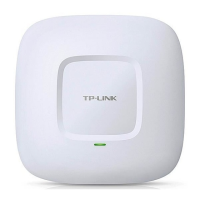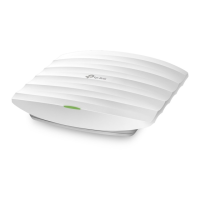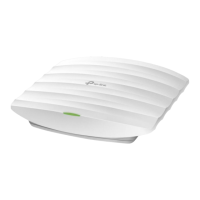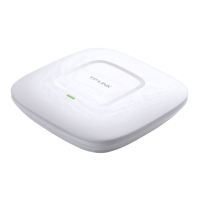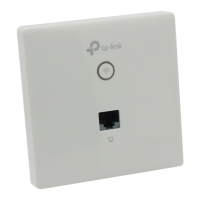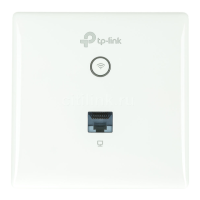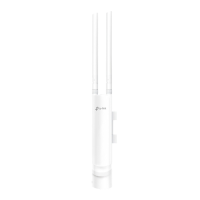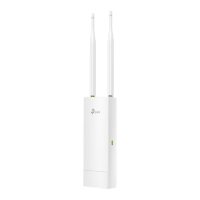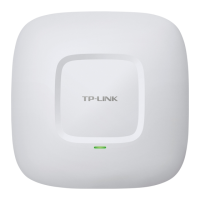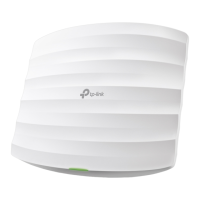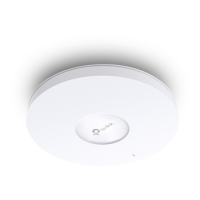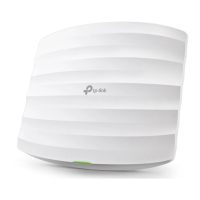Do you have a question about the TP-Link EAP115 and is the answer not in the manual?
Identifies the target audience, including network managers familiar with IT concepts and terminology.
Explains formatting, disclaimers, and provides links for additional information and support resources.
Provides a general description of EAP series products, their features, and 2.4GHz band capabilities.
Details the physical appearance of the EAP, including top view, panel layout, and mounting bracket.
Explains how to distinguish between Cluster and Standalone modes by examining web management page differences.
Guides users on how to switch the EAP's management mode between Cluster and Standalone.
Step-by-step instructions to complete the Quick Setup, with configurations synchronizing automatically.
Details the Cluster page, including customizing cluster names and managing the AP list within a cluster.
Covers wireless settings, portal, MAC filtering, scheduler, QoS, and rogue AP detection configurations.
Explains how to monitor network status and statistics for APs, SSIDs, and clients.
Focuses on device management and maintenance, including system logs, web server, and access control.
Covers system configurations like user account, time settings, reboot/reset, backup/restore, and firmware upgrade.
Allows configuration of the work mode and IP address for a standalone EAP device.
Details wireless settings, portal, MAC filtering, scheduler, QoS, and rogue AP detection for standalone EAPs.
Explains how to monitor the network running status and statistics for APs, SSIDs, and clients in standalone mode.
Covers device management and maintenance, including system logs, web server, and access control for standalone EAPs.
Details system configurations like user account, time settings, reboot/reset, backup/restore, and firmware upgrade for standalone EAPs.
Identifies the target audience, including network managers familiar with IT concepts and terminology.
Explains formatting, disclaimers, and provides links for additional information and support resources.
Provides a general description of EAP series products, their features, and 2.4GHz band capabilities.
Details the physical appearance of the EAP, including top view, panel layout, and mounting bracket.
Explains how to distinguish between Cluster and Standalone modes by examining web management page differences.
Guides users on how to switch the EAP's management mode between Cluster and Standalone.
Step-by-step instructions to complete the Quick Setup, with configurations synchronizing automatically.
Details the Cluster page, including customizing cluster names and managing the AP list within a cluster.
Covers wireless settings, portal, MAC filtering, scheduler, QoS, and rogue AP detection configurations.
Explains how to monitor network status and statistics for APs, SSIDs, and clients.
Focuses on device management and maintenance, including system logs, web server, and access control.
Covers system configurations like user account, time settings, reboot/reset, backup/restore, and firmware upgrade.
Allows configuration of the work mode and IP address for a standalone EAP device.
Details wireless settings, portal, MAC filtering, scheduler, QoS, and rogue AP detection for standalone EAPs.
Explains how to monitor the network running status and statistics for APs, SSIDs, and clients in standalone mode.
Covers device management and maintenance, including system logs, web server, and access control for standalone EAPs.
Details system configurations like user account, time settings, reboot/reset, backup/restore, and firmware upgrade for standalone EAPs.
| Frequency | 2.4GHz |
|---|---|
| Frequency Band | 2.4GHz |
| Maximum Data Rate | 300Mbps |
| Antenna Type | Internal |
| Number of Antennas | 2 |
| Operating Temperature | 0°C to 40°C (32°F to 104°F) |
| Storage Temperature | -40°C to 70°C (-40°F to 158°F) |
| Operating Modes | Access Point |
| Wireless Standards | IEEE 802.11n |
| Ethernet Ports | 1 x 10/100Mbps Ethernet Port (RJ-45) |
| Power Supply | 802.3af PoE |
| Dimensions | 160 mm x 35 mm x 120 mm |
| Weight | 0.295 kg |
| Operating Humidity | 10% to 90% non-condensing |
| Storage Humidity | 5% to 90% non-condensing |
| Wireless Functions | Multiple SSIDs |
| Wireless Security | WEP, WPA/WPA2, WPA-PSK/WPA2-PSK |
| Management | SNMP |
| Mounting | Ceiling / Wall Mounting |
| Data Rate | Up to 300Mbps (dynamic) |
